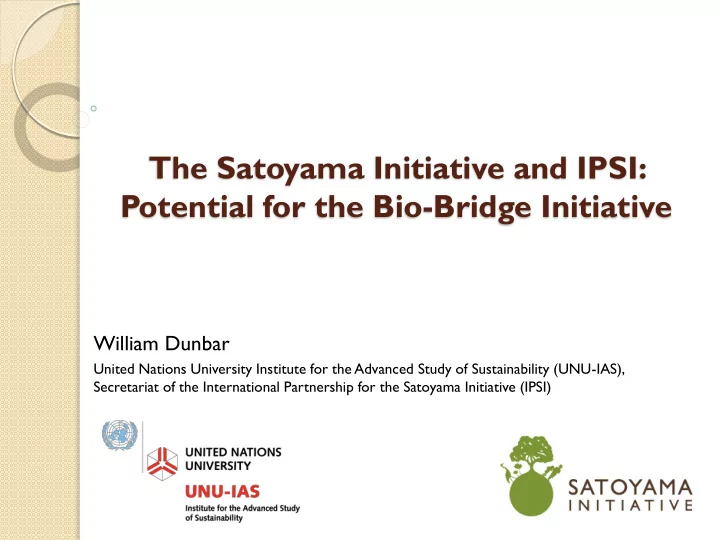

The Satoyama Initiative and IPSI: Potential for the Bio-Bridge Initiative William Dunbar United Nations University Institute for the Advanced Study of Sustainability (UNU-IAS), Secretariat of the International Partnership for the Satoyama Initiative (IPSI)
The Satoyama Initiative • A global effort to realize “societies in harmony with nature” • Promotes revitalization and sustainable management of “Socio -ecological Production Landscapes and Seascapes” around the world 2
Urbanization Overexploitation Threats and Challenges Industrialized agriculture Abandonment
Landscape The Americas approach benefits “Socio -ecological Production Landscapes and Seascapes” (SEPLS) • Support biodiversity while Europe providing humans with the goods and services needed for their well-being • Mutual benefits between human production and nature Asia • Dynamic mosaics of habitats and land uses • Deeply linked to local culture and knowledge all over the world 4
Development of the Satoyama Initiative •Initial research and the “Japan Satoyama Satoumi Assessment” 2006-2010 • Preparatory meetings in Tokyo (July) and Penang (October) 2009 • Global Workshop on the Satoyama Initiative in Paris (UNESCO) •“The Paris Declaration on the Satoyama Initiative” January 2010 • Calls for creation of an International Partnership • Paris Declaration submitted to CBD SBSTTA-14 as an info document May 2010 • IPSI launched at a CBD COP 10 Side Event in Nagoya • Recognition of the Satoyama Initiative and IPSI by CBD COP 10 October 2010 • Continued research on SEPLS, development of IPSI activities, growth of membership • Further recognition at CBD COP and other meetings 2010-2017
CBD COP Decisions involving the Satoyama Initiative and IPSI • X/32. Sustainable use of biodiversity – Recognizes the Satoyama Initiative as a potentially useful tool to better understand and support human- influenced natural environments for the benefit of biodiversity and human well- being… – Takes note of the International Partnership for the Satoyama Initiative as one mechanism to carry out activities… • XI/25. Sustainable use of biodiversity – …recognizes the contribution that the Satoyama Initiative is working to make in creating synergies among the various existing regional and global initiatives… • XII/5. Biodiversity for poverty eradication and sustainable development – Also taking into account relevant initiatives, such as the Satoyama Initiative… Invites Parties to raise awareness on best practices of sustainable use • XII/12. Article 8(j) and related provisions – Acknowledges that other initiatives, such as the International Partnership for the Satoyama Initiative (IPSI), consistent with decisions X/32 and XI/25, and in accordance with other international obligations, are contributing to the facilitation of the customary sustainable use of biological diversity; • XII/18. Sustainable use of biodiversity – Notes that the International Partnership for the Satoyama Initiative, consistent with decisions X/32 and XI/25, is working towards the sustainable use of biodiversity and its integration into the management of land, forests, and water resources; • XIII/3.Strategic actions to enhance the implementation of the Strategic Plan – Requests the Executive Secretary, subject to the availability of resources…To prepare and disseminate to Parties…further guidance on the concept of “sustainability” in food and agriculture with regard to biodiversity, and to promote and strengthen support for relevant information-sharing and technology transfer among Parties, in particular for developing countries, building on existing initiatives, where feasible, such as the Satoyama Initiative…
Major parts of the Satoyama Initiative • International Satoyama Initiative (ISI) project at UNU-IAS • International Partnership for the Satoyama Initiative (IPSI) – Secretariat at United Nations University Institute for the Advanced Study of Sustainability (UNU-IAS) • National network(s) 7
The International Partnership for the Satoyama Initiative (IPSI) • 220 member organizations (gov’t, NGO, private sector, academic, etc.) all over the world • Promotes networking and collaboration • Secretariat is UNU-IAS
Research / knowledge facilitation Publications All available for free download. Please browse under “UNU Collections”
Research / knowledge facilitation • Case Studies collection & analysis • Over 100 case studies publicly available
Resource mobilization / Capacity building • Community Development and Knowledge Management for the Satoyama Initiative (COMDEKS) Programme • Implemented by UNDP; Contribution from Japan Biodiversity Fund • Small-grant funding in 20 countries
Resource mobilization / Capacity building • Mainstreaming Biodiversity Conservation and Sustainable Management in Priority Socio-ecological Production Landscapes and Seascapes (“GEF -Satoyama Project”) • Funding from GEF; implemented by Conservation International • Subgrant funding; knowledge generation; and capacity-building in 3 priority ecosystems: Indo-Burma, Tropical Andes, and Madagascar and Indian Ocean Islands
Resource mobilization / Capacity building • Satoyama Development Mechanism (SDM) • Established by MOEJ, IGES and UNU-IAS • Seed funding to promising projects by IPSI members (up to USD 10,000) 2016 2017 Community-based activities Research activities Community-based activities Research activities Kenya Bangladesh India Kenya Kenya Bangladesh Ghana Chinese Taipei 1 2 1 2 3 4 3 4 Europe Chinese Colombia Philippines Taipei Cooperation among members Capacity-building Cooperation among members Capacity-building
Ongoing and future development for IPSI • Post-2020 CBD plans and SDGs – Post-Aichi Targets: landscape approaches, production activities in harmony with nature, etc. – NBSAP incorporation • Engagement with IPBES (LoA signed with UNU-IAS) – Providing inputs into assessments and disseminating outcomes • Expansion and mainstreaming of on-the-ground successes – Continued research and knowledge management • Diversification of membership and support – Particularly national governments and international organizations
Potential for Collaboration with Bio-Bridge (1) • What the Satoyama Initiative can provide: – On-the-ground: case studies and expertise at landscape level – Direct contribution as technical partner: UNU as the academic arm of the UN – Seed funding: Knock-on effects through funding mechanisms – Multi-level coordination: IPSI already has a network from local to global partners, and can complement national-level work – Experience and expertise on developing an initiative, funding mechanisms, knowledge base, etc.
Potential for Collaboration with Bio-Bridge (2) • What the Satoyama Initiative could use: – TSC needs of Parties: SI has bottom-up knowledge, but needs to match with Parties – Inclusion in platform as TSC provider: UNU and IPSI Secretariat – Active coordination between IPSI and Bio-Bridge secretariats: Information sharing, online resources, etc. – Parties to join IPSI: For improved cooperation and influence in CBD processes
Recommend
More recommend